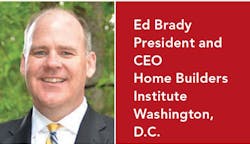Ed Brady on Training the Next Pool of Tradespeople: 'We're All in This Together'
For more than 50 years, Home Builders Institute (HBI) has provided construction career training to men and women exiting the military, at-risk youth, high school students, and adults looking for opportunities in the trades. Almost 8,000 individuals enrolled in HBI’s instruction programs in 2017, and 86 percent of its graduates were placed in construction industry jobs. About 700 state and local HBI chapters offer curriculum development, technical instruction, and job placement in partnership with 21 Job Corps centers, school districts, and other organizations serving former inmates, displaced workers, and people trying to transition into new careers.
Ed Brady took the helm of the nonprofit organization in October 2018, succeeding John Courson, who headed HBI for seven years before retiring.
Brady intends to continue expanding partnerships and programs and raising awareness of HBI as the go-to resource and teacher of skills for an industry grappling with a labor shortage.
During 30 years operating a home building company in central Illinois, he served as president of the Home Builders Association of Illinois, director of the Federal Home Loan Bank of Chicago, and was the 2016 chairman of the board at the National Association of Home Builders.
Q: What is HBI’s role in and impact on alleviating the industry’s skilled labor shortage?
A: HBI plays a vital role in alleviating the skills gap in our industry. As a builder for 30 years, I fully understand how a tight labor market affects production, pricing, and inventory.
At HBI, we hope to reach a level of training more than 20,000 industry professionals a year through various programs. We have curricula designed and written by industry professionals, meaning that those students who pass our certification process are job-ready, employable, and eager to get started.
Q: What specific plans or programs do you want to expand or introduce?
A: We have four main programs to support our curricula. Our Re-entry & Community Integration Programs train those seeking a second chance. Our Job Corps Program is the foundation of HBI, training at-risk youth in more than 70 resident training programs throughout the country. With our Veterans Program, we train soldiers—men and women who are exiting the military within 180 days. We are currently serving seven military installations.
All of these programs have the potential to grow and, in fact, if we want to reach 20,000 [individuals] a year, we need to grow these programs.
Finally, our fourth program serves high school and community college students. We now have licensees in more than 100 high schools and other educational entities. During the Great Recession—and it’s still the case today—many schools cut shop classes. Our culture shifted to four-year colleges and our kids stopped entering the trades, so the gap has grown.
With more than 22,000 high schools in the country, if we could get into just 5 percent of them with skills training in our industry, we could train a new generation of industry professionals. This program needs to expand quickly so we can repopulate an industry thirsting for a workforce.
Q: Builders and remodelers tend to see the shortage of qualified labor as their subcontractors’ problem to solve more so than their problem. Is that perception changing?
A: We’re all in this together. It will take a concerted effort working with builders and remodelers and all phases of the subcontractor level to overcome the shortfall.
Most of the building contractors in this country are small businesses that employ fewer than five people. In fact, it is the subcontractors that provide most of the skilled labor. So they need skills training directly to employ professionals. But we must also work with state governments, local school districts, state boards of education, parents, counselors, and school administrators to change the rhetoric around our profession.
Did you know that the average plumber earns $50,000 a year? These are well-paying jobs. But, as I said earlier, it will take a coalition of groups to build the workforce.
Q: How can/should builders engage with HBI? What is their role?
A: Builders need to identify the problem in their area. Each area is different; however, polling shows we need carpenters, electricians, painters, plumbers, and almost all of the trades in most areas. Get involved. HBI’s unique Five Steps of Service—connect, assess, train, certify and place—supports our students through the process. Work with your local Home Builders Association and talk to your local community leaders. HBI can help also. Contact us directly and we can walk you through the steps. Reach out to [email protected]. Support from local business and industry is imperative. We have the resources to help, but if you don’t ask, you won’t resolve the problem.
Q: What are your overall goals as president and CEO in 2019 and in the longer term?
A: My goal is to continue to build HBI as the go-to skills training leader in our industry. We have a dedicated and passionate workforce. They believe strongly in our mission.
At a macro level, I want us to train 20,000 professionals a year. But at a more micro level, I want us to continue to provide the best curricula and learning tools the industry can offer. We need to get better at our delivery process. We need to become more well known, raising the awareness of our value to the community and industry. We need to continue to advocate for those desiring to enter the industry at the local, state, and federal levels. We need to assist in changing the cultural perception that our industry is “not worthy.” Forums like this will help as we move toward that goal.
Q: Concerning finding and recruiting certified instructors, is there a big enough pool of candidates? Is HBI having any difficulty bringing in teachers?
A: As I mentioned earlier, our workforce is aging and there is no doubt many of these jobs are hard on your body. So, after 30 years, some may want to slow down and share their expertise. “Don’t give me two fish to eat, teach me how to fish and I’ll eat forever.” We need to find those individuals willing to give back and train the next generation. There are still many teachers out there who have the skills to teach in the trades. The important part is to teach the teacher how to teach. Say that three times quickly! Having qualified well-trained instructors is critical to our success, so we are always looking for good men and women who desire a career teaching, preparing, and certifying individuals for careers in the construction industry.

